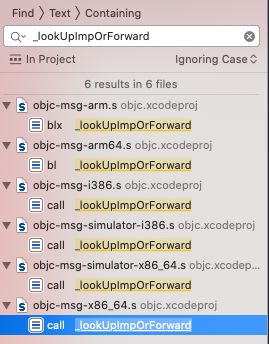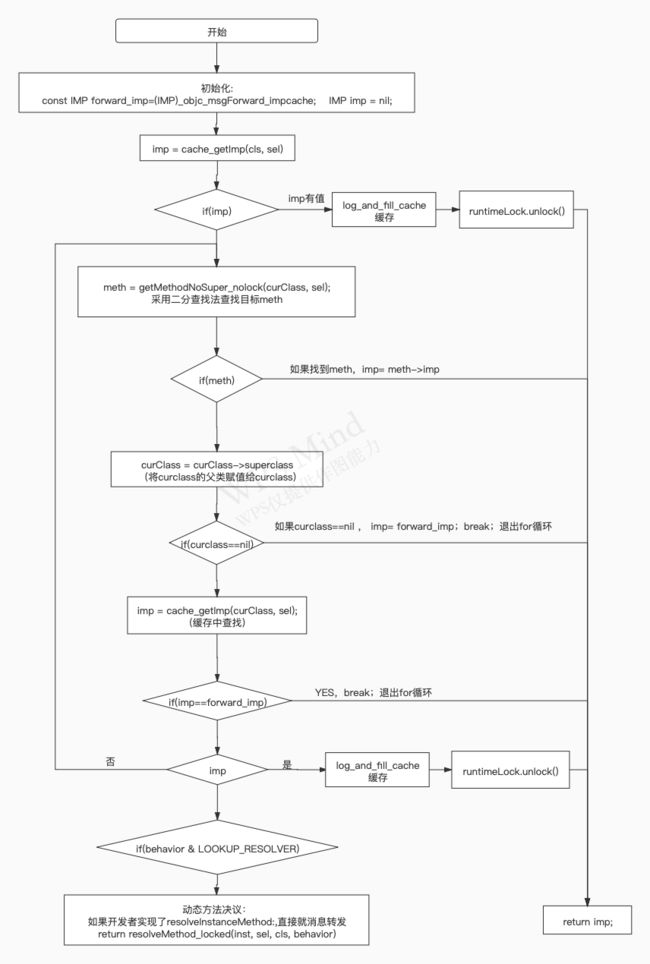前言: 上一节我们讲到cache缓存中快速查找imp的过程。那如果快速查找没有找到怎么办呢?关于接下来的查找过程又是怎样的呢?
我们回到objc_msgSend汇编部分,我们看到最后还是没有找到的话就会到JumpMiss
最终$0 == NORMAL,会走到__objc_msgSend_uncached。
.macro JumpMiss
.if $0 == GETIMP
b LGetImpMiss
.elseif $0 == NORMAL
b __objc_msgSend_uncached
.elseif $0 == LOOKUP
b __objc_msgLookup_uncached
.else
.abort oops
.endif
.endmacro
我们全局试图搜索__objc_msgSend_uncached,有搜索结果,我们找到objc-msg-arm64.s文件的STATIC_ENTRY __objc_msgSend_uncached, 从__objc_msgSend_uncached的实现里面,我们发现MethodTableLookup是核心代码
STATIC_ENTRY __objc_msgSend_uncached
UNWIND __objc_msgSend_uncached, FrameWithNoSaves
// THIS IS NOT A CALLABLE C FUNCTION
// Out-of-band p16 is the class to search
MethodTableLookup
TailCallFunctionPointer x17
END_ENTRY __objc_msgSend_uncached
于是我们找到MethodTableLookup的实现:
.macro MethodTableLookup
// push frame
SignLR
stp fp, lr, [sp, #-16]!
mov fp, sp
// save parameter registers: x0..x8, q0..q7
sub sp, sp, #(10*8 + 8*16)
stp q0, q1, [sp, #(0*16)]
stp q2, q3, [sp, #(2*16)]
stp q4, q5, [sp, #(4*16)]
stp q6, q7, [sp, #(6*16)]
stp x0, x1, [sp, #(8*16+0*8)]
stp x2, x3, [sp, #(8*16+2*8)]
stp x4, x5, [sp, #(8*16+4*8)]
stp x6, x7, [sp, #(8*16+6*8)]
str x8, [sp, #(8*16+8*8)]
// lookUpImpOrForward(obj, sel, cls, LOOKUP_INITIALIZE | LOOKUP_RESOLVER)
// receiver and selector already in x0 and x1
mov x2, x16
mov x3, #3
bl _lookUpImpOrForward
// IMP in x0
mov x17, x0
// restore registers and return
ldp q0, q1, [sp, #(0*16)]
ldp q2, q3, [sp, #(2*16)]
ldp q4, q5, [sp, #(4*16)]
ldp q6, q7, [sp, #(6*16)]
ldp x0, x1, [sp, #(8*16+0*8)]
ldp x2, x3, [sp, #(8*16+2*8)]
ldp x4, x5, [sp, #(8*16+4*8)]
ldp x6, x7, [sp, #(8*16+6*8)]
ldr x8, [sp, #(8*16+8*8)]
mov sp, fp
ldp fp, lr, [sp], #16
AuthenticateLR
.endmacro
从MethodTableLookup的实现里面,我们从字面意思发现_lookUpImpOrForward很关键,于是全局搜索_lookUpImpOrForward,但结果只有它的调用,没有实现。
既然在汇编部分没有,那么一定是在
C++或C,于是我们试着搜索lookUpImpOrForward,结果在objc-runtime-new.mm文件里面找到了lookUpImpOrForward的实现。
IMP lookUpImpOrForward(id inst, SEL sel, Class cls, int behavior)
{
const IMP forward_imp = (IMP)_objc_msgForward_impcache;
IMP imp = nil;
Class curClass;
runtimeLock.assertUnlocked();
if (fastpath(behavior & LOOKUP_CACHE)) {
imp = cache_getImp(cls, sel);
if (imp) goto done_nolock;
}
runtimeLock.lock();
checkIsKnownClass(cls);
if (slowpath(!cls->isRealized())) {
cls = realizeClassMaybeSwiftAndLeaveLocked(cls, runtimeLock);
}
if (slowpath((behavior & LOOKUP_INITIALIZE) && !cls->isInitialized())) {
cls = initializeAndLeaveLocked(cls, inst, runtimeLock);
}
runtimeLock.assertLocked();
curClass = cls;
for (unsigned attempts = unreasonableClassCount();;) {
Method meth = getMethodNoSuper_nolock(curClass, sel);
if (meth) {
imp = meth->imp;
goto done;
}
if (slowpath((curClass = curClass->superclass) == nil)) {
imp = forward_imp;
break;
}
// Halt if there is a cycle in the superclass chain.
if (slowpath(--attempts == 0)) {
_objc_fatal("Memory corruption in class list.");
}
// Superclass cache.
imp = cache_getImp(curClass, sel); // 有问题???? cache_getImp - lookup - lookUpImpOrForward
if (slowpath(imp == forward_imp)) {
break;
}
if (fastpath(imp)) {
goto done;
}
}
if (slowpath(behavior & LOOKUP_RESOLVER)) {
behavior ^= LOOKUP_RESOLVER;
return resolveMethod_locked(inst, sel, cls, behavior);
}
done:
log_and_fill_cache(cls, imp, sel, inst, curClass);
runtimeLock.unlock();
done_nolock:
if (slowpath((behavior & LOOKUP_NIL) && imp == forward_imp)) {
return nil;
}
return imp;
}
通过对源码的研读,大致得出lookUpImpOrForward的流程:
- 查找当前类的
methodLists里面是否有对应的imp,如果有直接返回imp。(Method meth = getMethodNoSuper_nolock(curClass, sel)) - 如果没有,查找父类的缓存里面是否有,如果缓存里面找到,直接返回
imp。(imp = cache_getImp(curClass, sel)) - 如果缓存里面没有,那么执行第二次的for循环,从父类的methodList寻找,然后缓存里面找....
.... - 如果一致没有找到,则一致for循环找到
NSObject类 - 如果在NSObject类里面还是没有找到,
NSObject类的父类是nil。会来到resolveMethod_locked(inst, sel, cls, behavior),看是否实现了resolveInstanceMethod:方法,如果实现,会消息转发resolveInstanceMethod:,这样我们就能在resolveInstanceMethod:里面拦截到我们的消息(sel)。 - 如果还是没有实现
resolveInstanceMethod,则会将forward_imp赋值给imp,返回imp。
以下是慢速查找流程图


